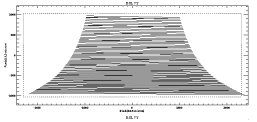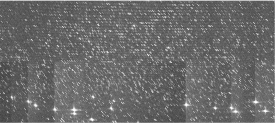 |
TRES
Reduction Tasks
|

|
![[TDC Home]](/images/tdc-home.gif)
![[TDC Search]](/images/tdc-search.gif)
![[OIR Home]](/images/oir-home.gif)
|
[Definitions] [Preparation] [Observing Protocol] [Quicklook)] [Quick Pipeline)] [Full Pipeline)] [Reduction Software] [Software Packages)] [Distribution] [Archiving]
 |
TRES
Reduction Tasks
|

|
![[TDC Home]](/images/tdc-home.gif)
![[TDC Search]](/images/tdc-search.gif)
![[OIR Home]](/images/oir-home.gif)
|
[Definitions] [Preparation] [Observing Protocol] [Quicklook)] [Quick Pipeline)] [Full Pipeline)] [Reduction Software] [Software Packages)] [Distribution] [Archiving]
|
Processing TRES data begins by making and going to a date-specific
processing directory separate from the raw data directory. Then all
of the spectra taken in a night are sorted by type, configuration,
and exposure time.
Bias and dark frames are processed by configuration and are used to monitor instrument performance, but not currently for anything else, though they may be optionally subtracted from all flat, comp, and object spectra. Flat fields are processed to get templates for spectrum extraction, apflattening correction images, scattered light correction masks, and echelle blaze correction spectra. Thorium-argon comparison lamp spectra are extracted using the flat template and cross-correlated against a reference spectrum with a known dispersion. The shift is applied, and the dispersion function is refit optionally interactively for the first spectrum of a configuration and fiber. Pixel dispersion shifts through the night are tabulated. After all of the night's calibration files are set up, TRES is such a stable instrument that object spectra can be extracted and calibrated automatically with a single command. |
0. Start IRAF and load the tres package by typing
ecl> tres
#-----------------------------------------------------------+
# TRES Data Reduction Package |
# Smithsonian Astrophysical Observatory |
# Telescope Data Center |
# Version 1.3.6 July 24, 2009 |
# Processing steps at |
# http://tdc-www.harvard.edu/instruments/tres/reduce.html |
#-----------------------------------------------------------+
btres tcal tflatlist tmakemask trsavg trsproc
ctres tcal1 tfset tmakeref trscode trssum
dtres tcemsao tgcomp tmaskfile trsdate tscat
ftres tcosmic tharadd tmodid trsdb tsetbcv
otres tdata tharlist tmonth trsdecode tskysub
qtres tdir tharplot tpmake trsdump ttres
skyplot tdisp tharset tpreamp trsfiles tvxcsao
stres tdispref thartable tpreproc trsgroup txdelete
tapref textract thistogram tproc trslist txdisp
tarith tfib tidref tpxcsao trsmed txhead
tbias1 tfib1 tlog tquick trspec txstat
tblaze tflat tmakeflat trelearn trsplot
tres>
If the banner message says *** Run trelearn to update parameters ***
type
tres> trelearn
If this task crashes, run it again. I haven't figured out how to deal
cleanly with deleted parameters, but added parameters will now appear
in your parameter files with their default values.
1. Go to the processing directory for the date you wish to process
tres> trsdate yyyy.mmdd
will put you in the correct working directory. The date is saved as a
parameter, so if you have to leave IRAF for some reason, or make sure
that you are in the right directory, all you have to to is type
tres> trsdate
Date for images (now=today) (2009.0311): [return]
tres> pwd
/home/user/tresq/2009.0311
2. Make lists of similarly configured files.
tres> trsgroup>
If trsgroup.redo=yes, the default value, old lists and the data.db file
will be deleted and a new, updated data.db file and derived lists will be written.
Useful lists for the most commonly used medium aperture, binned by 2b configuration
include:
BIASmbNNx0.0.list
DARKmbNNx600.list and/or DARKmbNNx900.list
FLATmb1FNx0.1.list FLATmb2NFx0.1.list
COMPmb1CNx0.5.list COMPmb2NCx0.5.list
3. Check bias files
tres> btres BIAS__NNx___.list
Run btres on lists of similarly configured bias files (BIASmbNNx600.list,
for example). A file called "bias"|apsize|binning".fits" (i.e. "biasmb.fits")
will be created. I check the bias count distribution by running the
thistogram task on these files.
4. Check dark files
tres> dtres DARK__NNx___.list
Run dtres on lists of similarly configured dark files (DARKmbNNx600.list,
for example). A file called "dark"|apsize|binning".fits" (i.e., "darkmb.fits)
will be created. I check the dark count distribution by running the
thistogram task on these files.
5. Process flat field files
tres> ftres FLAT__1FNx0.1.list
tres> ftres FLAT__2NFx0.1.list
Run ftres on lists of similarly configured flat files for each aperture
(FLATmb1FNx0.1.list and FLATmb2NFx0.1.list, for example). The list of
files will be processed and combined according to the ftres parameters.
Currently, I use cosmic=no and sumspec="median" to removed cosmic rays
without being affected by shifts in the cross-dispersion direction. The
resulting file is used as an aperture template using aptrace. I usually run
interact=yes so I can check the traces. A resulting aperture mask file,
"flat"|apsize|binning|fiber|".fits" and its associated database/ap file,
as well as a flattening file, "flat"|apsize|binning|fiber|".flat.fits",
will be created for each input list. The task which is called by ftres
to make these files from the reduced flat field image is called tmakeref.
Here is an example of how it runs.
When you run the second fiber for a given configuration, the two flattening
files will be combined into a single one, "flat"|apsize|binning|"12.flat.fits",
and a mask file for removing scattered light, "flat"|apsize|binning|"12.mask.fits",
will be derived from it. Scattered light will be removed from each flat image
using that mask file, and spectra will be extracted from the corrected
image. Those spectra, one per fiber, are normalized by their mean and
used to remove the echelle blaze function from object spectra. Two blaze
correction files, "flat"|apsize|binning|"1n.fits" and
"flat"|apsize|binning|"2n.fits" are created.
After wavelength calibration files are processed, the blaze correction
spectra can later be dispersion corrected and made into a spectrum of
the relative throughput between the two fibers using tpmake.
The background removal task, tskysub will call tpmake if the
throughput correction file is needed and not yet made.
6. Process Thorium Argon wavelength calibration files
tres> ttres COMP__1CNx0.5.list
tres> ttres COMP__2NCx0.5.list
Run ttres on all of the exposures of each fiber of each configuration.
You should run the longest exposure first, if there are multiple exposure
times for a configuration. I have been using the first exposure of the night
as the reference from which a running offset is computed.
To set a medium fiber binned standard, for example
tres> cat COMPmb12.list
0035.COMP.fits
0036.COMP.fits
0037.COMP.fits
0062.COMP.fits
0096.COMP.fits
0124.COMP.fits
tres> ttres COMPmb12.list compstd="first" compid+
compstd="first" will run tcal1 to fit dispersion functions for both
apertures of the first calibration file using a default ThAr spectra.
compid+ will put you in interactive mode to examine the lines which
are found and the fit the ecidentify task gets to them. Later ThAr
spectra in the list will use that first solution as the reference and
run reidentify after cross-correlating multiple orders in pixel space
to get a shift in wavelength which is then tabulated in a file called
"comp"|apsize|binning|fiber".shifts"
You can check the dispersion function by labelling major ThAr emission lines:
tres> tharplot [compfile].ec.fits
7. Process object spectra.
tres> trsproc o
trsproc runs otres on lists of similarly configured
object spectra. Simply edit the list of lists, "obj.list",
to just the files for which you want spectra, commenting out the others
by prepending a "#" to the line with the name of the file containing the
list of files for the undesired object. otres can be run on individual
object .list files, too.
8. To cross-correlate all (or most) of the orders of a resulting spectrum
against a template, use the tpxcsao task to do it in pixel space or
tvxcsao to do it in velocity space. I run twilight skies (object=SOLAR)
against each other as a test.